
Wine Culture and Information since 2002 - Volume 22
 Wine Culture and Information since 2002 - Volume 22 |
|
Italian Rose WinesThis month let's fill our glasses with three samples of rose wines, a comparative tasting for the discovering of fresh and pleasing aromas of flowers and fruits |
|
The world of rose wines, like we already said other times in the pages of our publication, is not very considered and not very attractive to consumers, the scarce interest for this wine can also be seen on its marketing. Whether rose wine has been subject to deprecable speculations in the past it is certainly true: not very scrupulous producers - probably attracted by the easy profits some fashions can ensure - were successful in demolishing the image of a wine which would certainly deserve a better attention. There are many good rose wines, as well as there are many mediocre and bad rose wines, but - after all - this consideration is valid for every type of wine, even for red wines, usually considered - at least in these times - wines par excellence. Despite the efforts of some associations and serious producers for the revaluation of rose wines, consumers still have a pretty marginal interest, considering them - like everyone knows - as wines being in the middle, neither whites, nor reds. In fact, rose wine is neither white nor red; it simply and legitimately is rose wine, that is a wine having a proper and specific identity and - in particular - represents an amazing world impossible to find in other categories of wines. Moreover rose wines have an excellent versatility in the enogastronomical matching: whenever a white wine is “too little” and a red wine is “too much”, rose wine represents most of the times the right solution. Italy - just like other wine countries of the world - has an interesting production of rose wines, from north to south, the choice of pink bottles is pretty vast and it is not difficult to find very good wines even in this category. Central-southern Italy is the area offering most of the production of rose wines - in particular Abruzzo with its Montepulciano d'Abruzzo Cerasuolo and Apulia with the roses of Salento - however even in the northern areas can be found good bottles, in particular near the lake of Garda and in the Alto Adige with the very good Lagrein Kretzer.
|
Rose wines offer their best qualities during youth, therefore - just like for most of white wines - allowing the aging in bottle is never appropriate, indeed, the risk of losing their best qualities is pretty high. It will right on these young wines - the ones belonging to the most recent vintages - we will concentrate our comparative tasting about rose wines. The production of rose wines in Italy is common in almost every region of the country, however the main areas from which these wines come, are concentrated in the central-southern regions, in the lake of Garda and in some areas of Alto Adige. The most typical region, the one which has been the first to be successful in the production of rose wines, is Apulia and in particular the Salento area. It is right in this area which is found the highest number of DOC areas (Denominazione d'Origine Controllata, Denomination of Controlled Origin) which provides, among the other styles, the production of rose wines. The wines selected for our comparative tasting about rose wines come from the most representative regions of central-southern Italy: Abruzzo, Apulia and Calabria. All the three wines are being vinified in inert containers, according to the most typical production system for rose wines which does not generally make use of cask or other wood containers. The first wine we selected is Cataldi Madonna's Montepulciano d'Abruzzo Cerasuolo Pie' delle Vigne, an interesting wine produced with 100% Montepulciano grape. The second wine is Salento Five Roses Anniversario from Leone de Castris - one of the most renowned rose wines of Italy - produced with Negroamaro and Malvasia di Lecce grapes. The third wine is Librandi's Terre Lontane - one of the most interesting roses of Calabria - produced with Gaglioppo and Cabernet Franc grapes. The three wines will be tasted in three ISO glasses and served at a temperature of 14°C (57°F), in order to favor both the development of aromas and the right perception of all the other organoleptic qualities.
|
||||||||
|
The color of rose wines depends on the production technique and - in particular - on the time of maceration of the skins in the must, a time which is measured in hours instead of days, as it is usually done for red wines instead. According to the Italian law, rose table wines - it should be remembered - can be produced with red grapes only and it is forbidden the blending with white wines. The only exception is represented by sparkling wines where it is allowed the blending of white and red wines in order to make the base wine or cuvée. Besides the maceration time of the skin, another fundamental factor for the determination of the color in rose wines is represented by the coloring capacity of the grape, a quality which is however regulated by the maceration time: the longer the maceration time, the higher the extraction of coloring substances. For this reason, the color of a rose wine can range from pale pink, sometimes with evident gray nuances, up to showing hues resembling ruby red. The first wine we are going to examine is Librandi's Terre Lontane. After having poured the wine on the first glass, we will evaluate the color of its mass: it will be noticed an intense cherry pink color and - by tilting the glass over a white surface - it will be noticed nuances of the same color. The second wine of which we will evaluate the color is Salento Five Roses Anniversario from Leone de Castris. By observing the mass, it will be noticed an intense cherry pink color, deeper than the previous wine, and by tilting the glass over a white surface, it will be noticed nuances of pale cherry pink. Let's now examine the third and last wine, Cataldi Madonna's Montepulciano d'Abruzzo Cerasuolo Pie' delle Vigne, and let's observe its color: in this case the pink hue gets a deeper color, very similar to ruby red: despite of this strong color, the wine however belongs to the category of rose wines. By tilting the glass it will be noticed nuances of intense cherry pink.
|
|
The world of rose wines is made of flowers and fruits expressing all their exuberant freshness. This probably is the most contradictory aspect of rose wines: the color resembling too much a red wine and the aromas very similar - for quality - to the ones of white wines. Whoever expects from a rose wine the strength and the power of red wines, can be easily disappointed; whoever expects the freshness of white wines transformed into red flowers and fruits, have in rose wine his or her best companion. The aromas of rose wines represent a world of its own, as well as a world of its own is represented by any other style of wine. The aromas of rose wines can be defined as the gentle expression of red grapes: whereas in red wines the aromas are strong and full, in rose wines produced with the same grapes, the aromas are more gentle and fresher, in other words, they express a polite dimension which in red wines is characterized by a more robust body. The first wine we will examine for the evaluation of aromas is Librandi's Terre Lontane, mainly produced with Gaglioppo - the most renowned red berried grape of Calabria - to which is added a part of Cabernet Franc. By holding the glass in vertical position - and without swirling - let's begin the evaluation of the opening aromas. The first smell will reveal aromas of cherry and raspberry, two qualities we will frequently find in many rose wines. After having swirled the glass in order to favor a proper oxygenation, we will do a second smell which will reveal aromas of strawberry, blueberry, plum and peach followed by flowery aromas recalling cyclamen and rose. Despite Gaglioppo and Cabernet Franc grapes are the protagonist of red wines having full aromas, whose fruits mainly recall the black berried ones, in rose wines are red berried fruits to prevail. The second wine of which we are going to examine aromas is Cataldi Madonna's Montepulciano d'Abruzzo Cerasuolo Pie' delle Vigne, the only wine of the three produced with a single grape - Montepulciano - whereas the others are the result of two different grapes. By holding the glass still, we will do the first smell in order to perceive opening aromas. Even in this case it will be possible to perceive aromas of cherry and raspberry as well as strawberry. After having swirled the glass, it will be done a second smell from which will be perceived aromas of blackberry and plum followed by aromas of peach and almond. The latter two aromas - despite they are frequently found in white wines - are typical in some rose wines as well. The last wine of which we will examine aromas is Salento Five Roses Anniversario from Leone de Castris. Opening aromas recall cherry, raspberry and strawberry: a quality we already found in the other two wines as well. After having swirled the glass, the second smell will reveal aromas of rose, peach and - like the previous wine - a pleasing hint of almond.
|
||||
|
The main gustatory qualities of rose wines are represented by crispness - also typical in white wines - to which is added a higher structure. This structure - of course - will never be full like the ones of red wines, however it certainly is superior than most of white wines. In the taste of rose wines will also be found flavors of the fruits generally perceived to the nose: a quality - together with crispness and structure - which is very useful in the enogastronomical matching. Let's begin the gustatory evaluation with Librandi's Terre Lontane. The first quality to be perceived in the mouth is represented by crispness, something which directly recalls white wines. The pleasing crispness is supported by a good structure which is also strengthened by a slight - and however perceptible - astringency, result of the maceration of the skin in the must. Astringency in rose wines will never be strong like the ones of reds: the tactile perception - in particular in the gums and in the internal side of cheeks - is so weak which usually requires a higher attention of the taster. The second wine of which we are going to evaluate its gustatory qualities is Cataldi Madonna's Montepulciano d'Abruzzo Cerasuolo Pie' delle Vigne. Even in this case the attack in the mouth is pretty crisp. As opposed to the previous wine, it will be noticed a fuller structure and a higher roundness, factors which efficiently contribute to the good balance of the wine. Interesting is also the evaluation of the alcohol and its role in the balance. Let's now examine the third and last wine, Salento Five Roses Anniversario from Leone de Castris. Even the attack of this wine is characterized by a pleasing and evident crispness. Just like in the previous wines, astringency - although it is light - is however perceptible and well balanced by alcohol. Finally, it should be noticed how the structure of this wine is fuller than the previous ones. Despite the main quality of the three samples is represented by crispness - a typical quality in rose wines - it should be noticed how the structure and the astringency change according to the type of grapes used for the production of each wine.
|
|
In the last phase of the tasting - besides evaluating the good taste-olfactory persistence of the three wines - it is interesting to pay attention on the organoleptic sensations which develop in the mouth after having swallowed the wine. The finish of Librandi's Terre Lontane will be characterized by flavors of raspberry, cherry and plum, whereas in Cataldi Madonna's Montepulciano d'Abruzzo Cerasuolo Pie' delle Vigne we will find flavors of raspberry, strawberry and peach. Finally, Salento Five Roses Anniversario from Leone de Castris will be characterized by flavors of strawberry and raspberry and a hint of almond. In all the three wines will be found a fresh and acid taste - absolutely coherent with the type - a precious factor for the enogastronomical matching. The final sensations of rose wines will always recall flavors of red fruits - of which the most frequent ones are raspberry, cherry and strawberry - organoleptic qualities which anticipate their presence in the aromas and that make rose wines extremely pleasing and fresh.
|
Wines of the Month |
|
|
|
Score legend Prices are to be considered as indicative. Prices may vary according to the country or the shop where wines are bought |
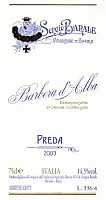
|
|
Barbera d'Alba Vigna Preda 2003 |
|
| Barale Fratelli (Piedmont, Italy) | |
| Grapes: Barbera | |
| Price: € 19.00 | Score: |
| The wine shows an intense ruby red color and nuances of ruby red, little transparency. The nose denotes intense, clean, pleasing and refined aromas which start with hints of raspberry, blackberry and cherry followed by aromas of blueberry, plum, violet, cyclamen, violet, vanilla and pink pepper. The mouth has good correspondence to the nose, a tannic attack and pleasing crispness, however balanced by alcohol, good body, intense flavors. The finish is persistent with flavors of cherry, raspberry and plum. A well made wine. This Barbera is produced with late harvested grapes, ages for 12 months in cask followed by 6 months of aging in bottle. | |
| Food Match: Roasted meat, Stewed and braised meat with mushrooms, Hard cheese | |
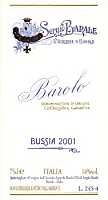
|
|
Barolo Vigna Bussia 2001 |
|
| Barale Fratelli (Piedmont, Italy) | |
| Grapes: Nebbiolo | |
| Price: € 39.00 | Score: |
| This Barolo shows a brilliant ruby red color and nuances of ruby red, moderate transparency. The nose reveals intense, clean, pleasing and refined aromas which start with hints of cherry and raspberry followed by aromas of violet, rose, cyclamen, plum, licorice, cinnamon, pink pepper, vanilla and menthol. The mouth has good correspondence to the nose, a tannic attack and pleasing crispness, however balanced by alcohol, full body, intense flavors. The finish is persistent with flavors of cherry, raspberry and strawberry. This Barolo ages for 3 years in cask followed by 2 years of aging in demijohn. | |
| Food Match: Game, Braised and stewed meat, Roasted meat | |
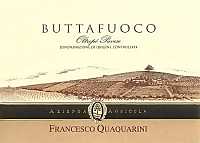
|
|
Oltrepò Pavese Buttafuoco 2004 |
|
| Quaquarini Francesco (Lombardy, Italy) | |
| Grapes: Croatina (50%), Barbera (30%), Ughetta di Canneto (20%) | |
| Price: € 4.15 | Score: |
| The wine shows an intense ruby red color and nuances of ruby red, little transparency. The nose reveals intense, clean and pleasing aromas which start with hints of cherry and raspberry followed by aromas of strawberry, blueberry, cyclamen, plum and rose. The mouth has good correspondence to the nose, a slightly tannic and effervescent attack, pleasing crispness, however balanced by alcohol, good body, intense flavors. The finish is persistent with flavors of cherry, raspberry and blueberry. | |
| Food Match: Sauteed meat with mushrooms, Stewed meat | |
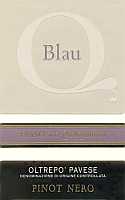
|
|
Oltrepò Pavese Pinot Nero Blau 2001 |
|
| Quaquarini Francesco (Lombardy, Italy) | |
| Grapes: Pinot Noir | |
| Price: € 5.65 | Score: |
| This wine shows a brilliant ruby red color and nuances of ruby red, moderate transparency. The nose denotes intense, clean and pleasing aromas which start with hints of cherry and plum followed by aromas of strawberry, raspberry, cyclamen, rose and vanilla. The mouth has good correspondence to the nose, a slightly tannic attack and pleasing crispness, however balanced by alcohol, good body, intense flavors. The finish is persistent with flavors of cherry, raspberry and strawberry. This Pinot Noir ages in barrique. | |
| Food Match: Sauteed meat with mushrooms, Roasted fish, Stuffed pasta | |
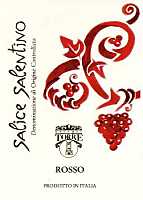
|
|
Salice Salentino Rosso 2002 |
|
| Vecchia Torre (Apulia, Italy) | |
| Grapes: Negroamaro (90%), Malvasia Nera (10%) | |
| Price: € 3.80 | Score: |
| This wine shows an intense ruby red color and nuances of ruby red, little transparency. The nose reveals intense, clean, pleasing and refined aromas which start with hints of black cherry, blackberry and plum followed by aromas of blueberry, violet, vanilla, licorice and carob. The mouth has good correspondence to the nose, a slightly tannic attack and however balanced by alcohol, good body, intense flavors. The finish is persistent with flavors of black cherry, blackberry and plum. This Salice Salentino ages for 6 months in cask. | |
| Food Match: Roasted meat, Broiled meat, Stewed meat | |
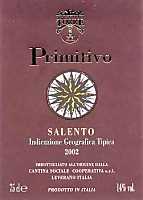
|
|
Primitivo 2002 |
|
| Vecchia Torre (Apulia, Italy) | |
| Grapes: Primitivo | |
| Price: € 4.00 | Score: |
| The wine shows an intense ruby red color and nuances of ruby red, little transparency. The nose reveals intense, clean, pleasing and refined aromas which start with hints of black cherry and plum followed by aromas of blackberry, blueberry, violet, vanilla and carob. The mouth has good correspondence to the nose, a slightly tannic attack and however balanced by alcohol, good body, intense flavors. The finish is persistent with flavors of black cherry, plum and blackberry. | |
| Food Match: Stewed and braised meat with mushrooms, Roasted meat, Hard cheese | |
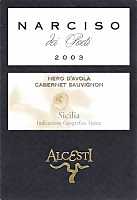
|
|
Narciso dei Poeti 2003 |
|
| Alcesti (Sicily, Italy) | |
| Grapes: Nero d'Avola, Cabernet Sauvignon | |
| Price: € 11.00 | Score: |
| This wine shows a brilliant ruby red color and nuances of ruby red, moderate transparency. The nose reveals intense, clean, pleasing and refined aromas which start with hints of blackberry and plum followed by aromas of black cherry, violet, vanilla, licorice, carob and tobacco. The mouth has good correspondence to the nose, a slightly tannic attack and however balanced by alcohol, good body, intense flavors, agreeable. The finish is persistent with flavors of plum and blackberry. Narciso dei Poeti ages for 6 months in barrique. | |
| Food Match: Stewed and braised meat with mushrooms, Roasted meat, Hard cheese | |
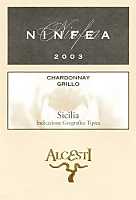
|
|
Ninfea 2004 |
|
| Alcesti (Sicily, Italy) | |
| Grapes: Chardonnay, Grillo | |
| Price: € 11.00 | Score: |
| This wine shows a brilliant straw yellow color and nuances of greenish yellow, very transparent. The nose reveals intense, clean, pleasing and refined aromas which start with hints of hazelnut, banana and grapefruit followed by aromas of acacia, hawthorn, passion fruit, apple, yeast, toasted, vanilla and praline. The mouth has good correspondence to the nose, a crisp attack and pleasing smoothness, however balanced by alcohol, good body, intense flavors, agreeable. The finish is persistent with flavors of banana, hazelnut and grapefruit. The Grillo grape used for the production of Ninfea ages for 6 months in steel tanks whereas the Chardonnay ages for 6 months in cask. | |
| Food Match: Stuffed pasta, Roasted fish, Roasted white meat | |
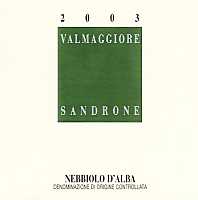
|
|
Nebbiolo d'Alba Valmaggiore 2003 |
|
| Sandrone (Piedmont, Italy) | |
| Grapes: Nebbiolo | |
| Price: € 25.00 | Score: |
| The wine shows a brilliant ruby red color and nuances of garnet red, moderate transparency. The nose denotes intense, clean, pleasing, refined and elegant aromas which start with hints of cherry and plum followed by aromas of raspberry, blueberry, violet, rose, vanilla, tobacco, licorice, cinnamon, pink pepper and menthol. The mouth has good correspondence to the nose, a tannic attack and pleasing crispness, however well balanced by alcohol, full body, intense flavors, pleasing roundness. The finish is persistent with flavors of cherry, raspberry, plum and blueberry. A well made wine. This Nebbiolo ages for 12 months in cask followed by an aging of 9 months in bottle. | |
| Food Match: Game, Roasted meat, Braised and stewed meat | |
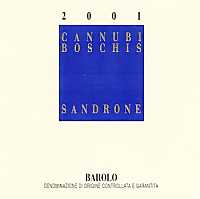
|
|
Barolo Cannubi Boschis 2001 |
|
| Sandrone (Piedmont, Italy) | |
| Grapes: Nebbiolo | |
| Price: € 70.00 | Score: |
| This Barolo shows an intense ruby red color and nuances of garnet red, moderate transparency. The nose reveals intense, clean, pleasing, refined and elegant which start with hints of cherry, plum and raspberry followed by aromas of violet, strawberry, blackberry, blueberry, vanilla, licorice, tobacco, cocoa, cinnamon, mace, pink pepper and menthol. The mouth has excellent correspondence to the nose, a tannic attack and pleasing crispness, however well balanced by alcohol, full body, intense flavors, pleasing roundness. The finish is very persistent with long flavors of cherry, plum, raspberry and blueberry. A very well made wine. This Barolo ages for 24 months in cask. | |
| Food Match: Game, Roasted meat, Stewed and braised meat, Hard cheese | |
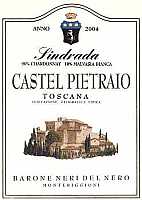
|
|
Sindrada 2004 |
|
| Fattoria di Castel Pietraio (Tuscany, Italy) | |
| Grapes: Chardonnay (90%), Malvasia Bianca (10%) | |
| Price: € 5.50 | Score: |
| This wine shows an intense straw yellow color and nuances of straw yellow, very transparent. The nose denotes intense, clean and pleasing aromas that start with hints of plum, banana and peach followed by aromas of pineapple, broom, pear and acacia. The mouth has good correspondence to the nose, a crisp attack and however balanced by alcohol, good body, intense flavors. The finish is persistent with flavors of plum and pear. | |
| Food Match: Pasta and risotto with fish, Fried fish, Sauteed fish | |
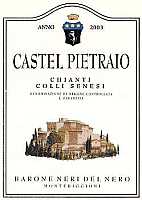
|
|
Chianti Colli Senesi Castel Pietraio 2003 |
|
| Fattoria di Castel Pietraio (Tuscany, Italy) | |
| Grapes: Sangiovese (95%), Canaiolo Nero (5%) | |
| Price: € 5.50 | Score: |
| The wine shows a brilliant ruby red color and nuances of ruby red, moderate transparency. The nose denotes intense, clean and pleasing aromas which start with hints of plum and black cherry followed by aromas of violet, raspberry, blueberry and vanilla. The mouth has good correspondence to the nose, a slightly tannic attack and pleasing crispness, however balanced by alcohol, good body, intense flavors. The finish is persistent with flavors of plum and black cherry. | |
| Food Match: Broiled meat and barbecue, Sauteed meat, Stuffed pasta | |
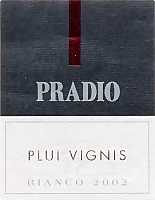
|
|
Friuli Grave Bianco Plui Vignis 2002 |
|
| Pradio (Friuli Venezia Giulia, Italy) | |
| Grapes: Chardonnay, Pinot Gris, Tocai Friulano | |
| Price: € 13.50 | Score: |
| This wine shows a brilliant golden yellow color and nuances of straw yellow, very transparent. The nose reveals intense, clean, pleasing and refined aromas which start with hints of plum and hazelnut followed by aromas of pineapple, banana, yeast, hawthorn, broom, pear, apple, papaya and vanilla. The mouth has good correspondence to the nose, a crisp attack and pleasing roundness, however balanced by alcohol, good body, intense flavors. The finish is persistent with flavors of plum, pineapple and apple. Plui Vignis ferments in barrique. | |
| Food Match: Mushrooms and fish soups, Roasted fish, Stuffed pasta, Roasted white meat | |
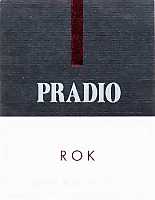
|
|
Friuli Grave Rosso Rok 2001 |
|
| Pradio (Friuli Venezia Giulia, Italy) | |
| Grapes: Cabernet Sauvignon, Merlot | |
| Price: € 15.30 | Score: |
| This wine shows an intense ruby red color and nuances of ruby red, little transparency. The nose reveals intense, clean, pleasing, refined and elegant aromas which start with hints of black currant, black cherry and plum followed by aromas of raspberry, blueberry, violet, vanilla, tobacco, eucalyptus, licorice and pink pepper. The mouth has good correspondence to the nose, a tannic attack and however balanced by alcohol, good body, intense flavors. The finish is persistent with flavors of black cherry, plum and black currant. A well made wine. Rok ages for 16 months in barrique. | |
| Food Match: Roasted meat, Stewed and braised meat, Hard cheese | |
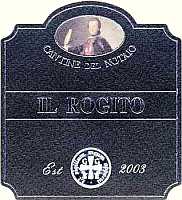
|
|
Il Rogito 2003 |
|
| Cantine del Notaio (Basilicata, Italy) | |
| Grapes: Aglianico | |
| Price: € 12.00 | Score: |
| This wine shows a pale ruby red color and nuances of cherry pink, moderate transparency. The nose reveals intense, clean, pleasing and refined aromas which start with hints of cherry, raspberry and vanilla followed by aromas of strawberry, blackberry, plum, cyclamen and rose. The mouth has good correspondence to the nose, a crisp attack and however balanced by alcohol, good body, intense flavors, pleasing roundness. The finish is persistent with flavors of cherry, raspberry and blackberry. Il Rogito ages for 12 months in cask. | |
| Food Match: Stuffed pasta, Roasted fish, Fish soups, Roasted white meat | |
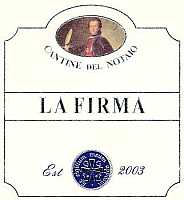
|
|
Aglianico del Vulture La Firma 2003 |
|
| Cantine del Notaio (Basilicata, Italy) | |
| Grapes: Aglianico | |
| Price: € 32.00 | Score: |
| The wine shows an intense ruby red color and nuances of ruby red, little transparency. The nose reveals intense, clean, pleasing, refined and elegant aromas which start with hints of blackberry, black cherry and plum followed by aromas of violet, vanilla, tobacco, black currant, licorice, carob, black pepper, mace and menthol. The mouth has good correspondence to the nose, a tannic attack and however balanced by alcohol, full body, intense flavors. The finish is persistent with flavors of black cherry, plum and blackberry. A well made wine. La Firma ages in cask for 12 months followed by 4 months of aging in bottle. | |
| Food Match: Braised and stewed meat, Roasted meat, Game, Hard cheese | |
|
||||||||
|
DiWineTaste Polls
|
| |||||||
Privacy Policy | |||||||


| Copyright © 2002-2024 Antonello Biancalana, DiWineTaste - All rights reserved |
| All rights reserved under international copyright conventions. No part of this publication and of this WEB site may be
reproduced or utilized in any form or by any means, electronic or mechanical, without permission in writing from DiWineTaste. |